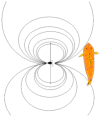Schooling Fish from a New, Multimodal Sensory Perspective
- PMID: 38998096
- PMCID: PMC11240491
- DOI: 10.3390/ani14131984
Schooling Fish from a New, Multimodal Sensory Perspective
Abstract
The acoustic hypothesis suggests that schooling can result in several benefits. (1) The acoustic pattern (AP) (pressure waves and other water movements) produced by swimming are likely to serve as signals within fish shoals, communicating useful spatial and temporal information between school members, enabling synchronized locomotion and influencing join, stay or leave decisions and shoal assortment. (2) Schooling is likely to reduce the masking of environmental signals, e.g., by auditory grouping, and fish may achieve windows of silence by simultaneously stopping their movements. (3) A solitary swimming fish produces an uncomplicated AP that will give a nearby predator's lateral line organ (LLO) excellent information, but, if extra fish join, they will produce increasingly complex and indecipherable APs. (4) Fishes swimming close to one another will also blur the electrosensory system (ESS) of predators. Since predators use multimodal information, and since information from the LLO and the ESS is more important than vision in many situations, schooling fish may acquire increased survival by confusing these sensory systems. The combined effects of such predator confusion and other acoustical benefits may contribute to why schooling became an adaptive success. A model encompassing the complex effects of synchronized group locomotion on LLO and ESS perception might increase the understanding of schooling behavior.
Keywords: electrosensory system; evolution; lateral line organ; predator confusion.
Conflict of interest statement
The author declares no conflicts of interest.
Figures





Similar articles
-
Tail Beat Synchronization during Schooling Requires a Functional Posterior Lateral Line System in Giant Danios, Devario aequipinnatus.Integr Comp Biol. 2021 Sep 8;61(2):427-441. doi: 10.1093/icb/icab071. Integr Comp Biol. 2021. PMID: 33982077 Free PMC article.
-
Is the Capacity for Vocal Learning in Vertebrates Rooted in Fish Schooling Behavior?Evol Biol. 2018;45(4):359-373. doi: 10.1007/s11692-018-9457-8. Epub 2018 Jun 13. Evol Biol. 2018. PMID: 30459479 Free PMC article. Review.
-
Energy conservation by collective movement in schooling fish.Elife. 2024 Feb 20;12:RP90352. doi: 10.7554/eLife.90352. Elife. 2024. PMID: 38375853 Free PMC article.
-
Bioluminescent flashes drive nighttime schooling behavior and synchronized swimming dynamics in flashlight fish.PLoS One. 2019 Aug 14;14(8):e0219852. doi: 10.1371/journal.pone.0219852. eCollection 2019. PLoS One. 2019. PMID: 31412054 Free PMC article.
-
Incidental sounds of locomotion in animal cognition.Anim Cogn. 2012 Jan;15(1):1-13. doi: 10.1007/s10071-011-0433-2. Epub 2011 Jul 12. Anim Cogn. 2012. PMID: 21748447 Free PMC article. Review.
Cited by
-
Spatiotemporal Dynamics of Fish Density in a Deep-Water Reservoir: Hydroacoustic Assessment of Aggregation Patterns and Key Drivers.Animals (Basel). 2025 Apr 7;15(7):1068. doi: 10.3390/ani15071068. Animals (Basel). 2025. PMID: 40218461 Free PMC article.
References
-
- Masuda R., Tsukamoto K. School formation and concurrent developmental changes in carangid fish with reference to dietary conditions. Environ. Biol. Fishes. 1999;56:243–252. doi: 10.1023/A:1007565508398. - DOI
-
- Radakov D.V. Schooling in the Ecology of Fish. John Wiley; New York, NY, USA: 1973.
-
- Kasumyan A.O., Pavlov D.S. On the Problem of the Evolutionary Origin of Schooling Behavior of Fish. J. Ichthyol. 2023;63:1374–1389. doi: 10.1134/S0032945223070135. - DOI
LinkOut - more resources
Full Text Sources
Miscellaneous

